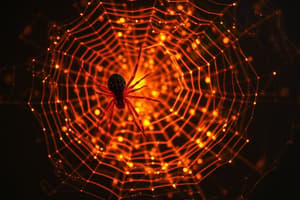Podcast
Questions and Answers
What are sea spiders?
What are sea spiders?
- Found on land
- A type of fish
- Common in warm waters
- Members of the class Pycnogonida (correct)
What does the diet of sea spiders consist of?
What does the diet of sea spiders consist of?
Cnidarian polyps and ectoprocts
What is a proboscis?
What is a proboscis?
A structure that feeds by sucking prey tissues
What are chelifores used for?
What are chelifores used for?
How many pairs of walking legs do sea spiders have?
How many pairs of walking legs do sea spiders have?
Segments in Pycnogonids are standard like in other chelicerates.
Segments in Pycnogonids are standard like in other chelicerates.
What are ovigers?
What are ovigers?
Describe the gonads of Pycnogonids.
Describe the gonads of Pycnogonids.
Gonopores are located on one of the pairs of legs, where the female releases _____ and the male fertilizes them.
Gonopores are located on one of the pairs of legs, where the female releases _____ and the male fertilizes them.
Flashcards are hidden until you start studying
Study Notes
Sea Spiders Overview
- Sea spiders are members of the class Pycnogonida, primarily inhabiting cold ocean floor waters.
- Commonly found in various marine environments, they play a role in the ecosystem as predators.
Diet and Feeding Mechanism
- Their diet mainly consists of cnidarian polyps and ectoprocts, which they extract for nourishment.
- Sea spiders utilize a proboscis to suck tissues from prey, allowing for efficient feeding.
Anatomical Features
- Equipped with chelifores, which are the first pair of appendages used to tear apart prey.
- They possess four pairs of elongated, thin walking legs that aid in navigation and locomotion.
- Pycnogonids exhibit a unique feature among arthropods: they possess five or six pairs of legs due to segment duplication instead of the common four pairs found in other chelicerates.
Reproductive Characteristics
- Males have a subsidiary pair of legs known as ovigers, which are used to carry developing eggs; these structures are often missing in females.
- Gonads of Pycnogonids are U-shaped, with branches extending into each leg, highlighting their unique reproductive adaptations.
- The female releases eggs from one of the leg pairs, while the male fertilizes them; fertilized eggs are attached to the ovigers for brooding until they hatch.
Studying That Suits You
Use AI to generate personalized quizzes and flashcards to suit your learning preferences.





